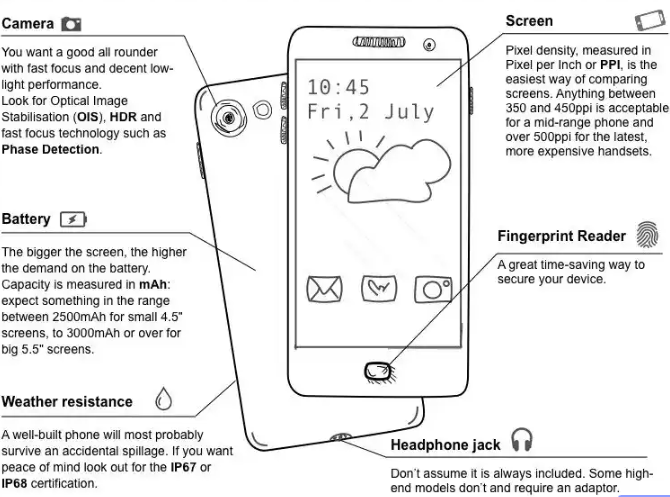Buying your first smartphone can feel overwhelming with so many options available. But with the right approach, you can make the process simple and find the phone that fits your needs. This guide covers 5 key points every first-time buyer in Uganda should consider to make an informed decision.
Key Takeaways:
- Set a realistic budget and avoid overspending.
- Understand your needs: Whether for work, photography, or gaming, knowing what you want helps narrow down options.
- Prioritize essential specifications like display, battery life, and processor.
- Choose between Android or iOS based on your preferences and budget.
- Future-proof your phone with 4G/5G, long-term software updates, and durability.
Set a Realistic Budget
The first step in choosing a smartphone is deciding how much you're willing to spend. In Uganda, smartphones range from UGX 300,000 to over UGX 5,000,000.
- Entry-level phones (UGX 300,000–UGX 700,000) are perfect for calls, messaging, and social media.
- Mid-range phones (UGX 700,000–UGX 1.5 million) offer better performance, camera quality, and battery life.
- Premium phones (UGX 2 millions+) provide top-tier performance, cameras, and faster processing.
Tip: Focus on what you need, not the latest features or the most expensive brand.
Consider Your Needs and Lifestyle
Think about how you plan to use your phone. Your daily activities will help you choose the best phone.
- Students need a phone with long battery life and apps for note-taking and online classes.
- Content lovers should look for a phone with a good display, plenty of storage, and strong battery life.
- Mobile photographers need a phone with a good camera setup, like Night Mode and stabilization.
- Professionals may want a phone with great multitasking capabilities, fast performance, and secure storage.
Uganda Insight:
Uganda’s mobile landscape is rapidly evolving. According to recent statistics, the country has reached over 38.6 million cellular connections, which is around 76 SIM cards per 100 people. However, this doesn’t mean every individual owns a phone; many carry multiple SIMs for different networks and purposes.
The Uganda Communications Commission (UCC) estimates that true mobile phone ownership among adults is around 59%, with variations depending on gender, region, and access to education.
Sources: © Statista 2025
Know the Essential Specs
- Display: Look for at least a 6.5-inch screen with Full HD+ resolution for better clarity.
- Battery: Choose a phone with a 4000mAh battery or higher, and fast charging (18W+).
- Processor: A Snapdragon or MediaTek processor will ensure smoother performance for apps and gaming.
- Storage & RAM: Aim for 64GB storage and 4GB RAM. More storage and RAM are needed for heavy users.
- Camera: Look for Night Mode, wide-angle lenses, and stabilization features instead of just megapixels.
Android vs iPhone: Which One Fits You?
The two major operating systems are Android and iOS (iPhone). Here's how they compare:
Feature | Android (e.g., Redmi, Nokia) | iPhone (e.g., iPhone Pro, iPhone 13) |
Price Range | Affordable to Premium | Premium |
Customization | High (custom ROMs, widgets) | Limited |
Updates | Varies by brand | Long-term support |
App Store | Google Play Store | Apple App Store |
Tip: Android offers a wide variety of affordable options, while iPhones offer a seamless experience with long-term software support. Choose based on your budget and the features you care about most.
Think Long-Term: Is the Phone Future-Proof?
Consider how long the phone will last. A phone should support future apps and network updates, so look for:
- 4G/5G support for faster internet access.
- Regular software updates (especially for Android phones).
- Durable build (prefer metal or glass over plastic).
- Water and dust resistance (IP67/68 rating).
- Security features like fingerprint or Face Unlock.
Tip: A future-proof phone saves you from upgrading too soon.
Popular Picks for First-Time Buyers in Uganda (2024–2025)
Price Range | Recommended Phones |
Budget | |
Mid-range | |
Flagship | |
Camera Lovers |
Our Final Advice
The first smartphone doesn’t have to feel overwhelming. Your budget, daily needs, and key features will guide the selection of a device that suits your lifestyle. A phone for photography, productivity, or staying connected can be easily found without overspending. With careful consideration, the perfect smartphone is within reach.
Need help making your final choice? Visit GadgetCraze Uganda for expert reviews, phone comparisons, and personalized buying guides. Don’t miss out on the latest deals and exclusive offers to get the best value on your first smartphone purchase today!
Frequently Asked Questions (FAQs)
Q1: What is the best phone for a first phone?
For most people, mid-range Android phones like the Samsung Galaxy A series or the Redmi Note series are a great starting point. For iPhone lovers, the iPhone SE is a solid entry option.
Q2: How do you check if a phone is good before buying?
- Read user reviews and YouTube hands-on videos.
- Compare specs on trusted sites.
- Test the phone in a store (if possible).
- Ask about warranty and after-sales support.
Q3: What is the first thing you do when you buy a phone?
Charge it fully, insert your SIM card, and go through the initial setup (language, Wi-Fi, account login). Then, update the system software if needed.
Q4: What is the first thing you do when you get a new phone?
Install essential apps, secure your phone with a PIN or fingerprint, and back up your data. Also, consider buying a case and screen protector immediately.
Q5: How do you check if a phone is good before buying?
Check the brand, operating system, and performance. Don’t rely on looks or camera specs alone—focus on reliability, reviews, and features that match your needs.